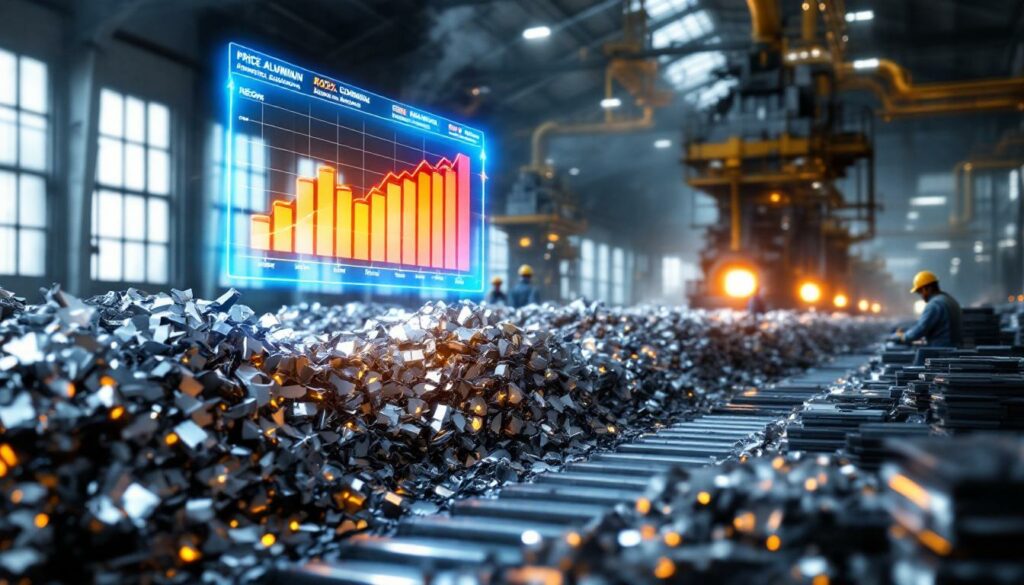Aluminum Scrap Market Dynamics: Understanding Price Movements and Regional Variations
The secondary aluminum market operates on a complex interplay of primary metal prices, regional variations, and seasonal factors. Understanding these dynamics allows traders, manufacturers, and buyers to navigate price movements strategically and identify potential opportunities in this evolving market landscape.
What's Driving Current Aluminum Scrap Pricing Trends?
The Relationship Between Primary and Secondary Aluminum Markets
The decline in primary aluminum prices drives the weakness in aluminum scrap, establishing a foundational relationship that ripples throughout the secondary metals ecosystem. Primary aluminum (A00) prices currently sit at 20,770 yuan/mt, having decreased by 90 yuan/mt in the latest trading session according to Shanghai Metal Market (SMM) data.
This primary market movement creates predictable spreads in the secondary market. The price difference between A00 aluminum and mixed aluminum extrusion scrap in Foshan has narrowed to 1,767 yuan/mt (tightening by 90 yuan/mt), while in Shanghai, mechanical casting aluminium scrap price assessments trades at a 1,836 yuan/mt discount to A00 (narrowing by 10 yuan/mt).
These spreads function as critical indicators for scrap processors and secondary alloy producers, directly impacting profit margins and procurement strategies. Historically, such compression signals challenging operating conditions for scrap processors who rely on healthy spreads to maintain profitability.
"The secondary market typically follows primary aluminum with a 3-5 day lag, though regional variations can extend this delay to weeks in less liquid markets," notes SMM's analysis.
Regional Market Divergence Analysis
Market response velocity varies dramatically by region, creating geographic arbitrage opportunities for savvy traders. In immediate-response regions like Shanghai, Jiangsu, and Shandong, prices adjusted downward by 50-100 yuan/mt following the primary aluminum decrease. These areas feature high trading volumes, efficient information flow, and price-sensitive market participants.
In sharp contrast, delayed-response regions including Jiangxi, Foshan, Guizhou, and Hunan maintained unchanged quotations despite the broader market movement. This price stickiness stems from several factors:
- Contract structures: Foshan's predominance of fixed-term contracts reduces spot market sensitivity
- Transportation barriers: Guizhou's mountainous geography creates logistical challenges that isolate pricing
- Information asymmetry: Smaller markets like Jiangxi experience slower dissemination of market intelligence
- Trading volume deficiencies: Hunan's lower transaction frequency creates price inertia
These regional disparities create potential arbitrage opportunities for traders who can navigate the transportation logistics and relationship networks necessary to capitalize on temporary price differentials.
How Are Seasonal Factors Affecting the Aluminum Scrap Market?
High-Temperature Season Impact
July marks the beginning of what industry participants call the "high-temperature off-season" – a period when both production and consumption patterns shift dramatically. According to SMM data, this seasonal factor, combined with elevated aluminum prices, has triggered production reductions across downstream industries.
The impact manifests in several ways:
- Equipment strain: Secondary smelters face increased maintenance requirements due to thermal stress
- Worker productivity: Labor-intensive scrap sorting operations become less efficient in extreme heat
- Energy concerns: Power consumption peaks during summer, raising costs for energy-intensive processes
- Reduced orders: Construction and automotive sectors typically slow during summer months
Historical patterns show July-August typically sees a 15-20% reduction in secondary aluminum production capacity utilization compared to spring months. This seasonal dip usually triggers commodity market volatility as the market adjusts to changing supply-demand dynamics.
Supply-Demand Imbalance Factors
The current market faces a dual challenge of raw material constraints and demand weakness. SMM reports that secondary aluminum manufacturers are implementing strategic production adjustments through:
- Short-term furnace shutdowns for maintenance
- Reduced operating rates across production lines
- Selective processing focusing on highest-margin scrap types
- Labor force reductions at sorting facilities
These adjustments come in response to both raw material supply deficits and weak downstream demand. The imbalance has created operational challenges particularly for manufacturers without integrated scrap sourcing networks or diversified customer bases.
"Without substantial demand improvements, prices encounter resistance, but the cost support logic remains," according to SMM analysis.
The sector-wide operating rate reduction protects margins while preventing inventory accumulation during seasonal demand weakness. Manufacturers typically maintain 70-80% of normal capacity during this period to balance fixed costs against market conditions.
What's Happening in the Cast Aluminum Alloy Market?
Current Price Stability Analysis
Despite downward pressure from primary aluminum, ADC12 cast aluminum alloy prices have demonstrated remarkable stability, holding steady at 20,000-20,200 yuan/mt according to SMM assessments. This price resilience suggests underlying strength in the specialized alloy segment despite broader market weakness.
Several factors contribute to this stability:
- End-use specifications: ADC12's specific chemistry requirements limit substitution options
- Production complexity: The specialized casting process creates barriers to entry and supply adjustments
- Inventory management: Producers have maintained disciplined production to prevent oversupply
- Stable export markets: International demand has partially offset domestic weakness
The price stability comes despite weakness in the futures market, where the AD2511 contract closed at 19,785 yuan/mt, down 90 yuan/mt, with 1,720 lots traded. This resilience highlights the sometimes-divergent nature of physical and financial markets.
Futures Market Influence
The spot-futures relationship provides crucial insights into market sentiment and potential price direction. The spot-futures spread has narrowed to 180 yuan/mt according to SMM data from July 4, indicating convergence of short and medium-term price expectations.
Market activity shows futures-to-spot traders have become increasingly active, with delivery brand trading volumes rising as bull positions get reduced. This pattern typically emerges when:
- Speculative long positions become less confident in continued price appreciation
- Physical market participants hedge forward positions more aggressively
- Arbitrage opportunities between spot and futures contracts narrow
- Market sentiment shifts toward neutral or bearish outlooks
The contract's open interest stands at 9,004 lots, reflecting substantial ongoing participation despite recent price declines. This sustained interest suggests market participants remain engaged despite seasonal challenges.
How Are Import-Export Dynamics Affecting Domestic Prices?
International Price Comparison
Global price relationships create additional complexity in the aluminum scrap ecosystem. The CIF import price for ADC12 remains stable at $2,450-2,480/mt, translating to an import spot price around 19,200 yuan/mt after duties and logistics.
This creates an approximately 800 yuan/mt import loss for ADC12, effectively creating a price floor through import substitution economics. When domestic prices fall too far below international parity, imports naturally decline, supporting local pricing.
Regional price variations add another dimension to this dynamic:
| Region | Price | Format | Notes |
|---|---|---|---|
| China (domestic) | 20,000-20,200 yuan/mt | ADC12 | SMM assessed range |
| Thailand | 82-83 Thai baht/kg | Tax-free ADC12 | Approximately 19,500 yuan/mt equivalent |
| CIF China | $2,450-2,480/mt | ADC12 | Before duties and logistics |
The Thailand tax-free ADC12 price of 82-83 Thai baht/kg represents a key reference point for southeast Asian supply chains, with significant implications for southern Chinese markets in particular.
Arbitrage Opportunities Assessment
The current import loss situation creates strategic positioning opportunities for different market participants. With domestic prices exceeding import parity by approximately 800 yuan/mt, importers face challenging economics.
However, this spread creates several strategic options:
- Domestic suppliers: Maintain price premiums while import competition remains subdued
- End users: Leverage import threat to negotiate with domestic suppliers
- Traders: Position for potential arbitrage if spreads narrow through either domestic price declines or international price increases
- Producers with international sourcing: Blend imported raw materials with domestic scrap to optimize costs
These dynamics remain fluid, with exchange rates, logistics costs, and tariff policies all influencing the ultimate arbitrage equation. Current logistics disruptions in key shipping lanes have added approximately $30-40/mt to import costs, further complicating the calculation.
What Inventory Trends Are Shaping Market Sentiment?
Current Inventory Statistics
Inventory levels provide a crucial barometer of market balance and potential price pressure. According to SMM data from July 4, total social inventory of secondary aluminum alloy ingots across key markets (Foshan, Ningbo, and Wuxi) has reached 21,988 metric tons.
This represents significant recent accumulation:
- Short-term increase: 356 mt from the previous trading day (+1.6%)
- Weekly growth: 2,466 mt from the previous Friday (+12.6%)
The accelerating inventory buildup signals potential oversupply, with Foshan warehouses experiencing the most rapid accumulation. This regional concentration suggests southern China's automotive and export markets face particular demand challenges.
Inventory-to-Price Relationship
Historical inventory patterns show the current accumulation rate exceeds typical seasonal norms by approximately 30%. Past cycles indicate inventory levels above 25,000 metric tons typically trigger significant price corrections in the 500-700 yuan/mt range.
The inventory turnover rate has slowed to approximately 8-10 days from the more typical 5-7 days, further indicating consumption weakness. This extended holding period increases financing costs for inventory holders, potentially forcing liquidation if the trend continues.
Several factors influence this inventory-price relationship:
- Seasonal patterns: Summer typically sees 8-12% inventory increases
- Regional distribution: Concentrated buildup creates more price pressure than dispersed inventory
- Inventory financing costs: Rising interest rates increase carrying costs
- Export potential: International demand can sometimes absorb domestic surplus
Market participants closely monitor daily and weekly inventory changes as leading indicators of potential price movements, with accelerating accumulation typically preceding price declines by 7-10 days.
What's the Outlook for Aluminum Scrap Prices?
Short-Term Price Projection Factors
The aluminum scrap market faces conflicting pressures that will determine price direction in the coming weeks. SMM analysis suggests prices will "fluctuate rangebound in the short term" as various factors create both support and resistance:
Supportive Factors:
- Cost floor: Primary aluminum prices establish minimum viable scrap prices
- Production discipline: Secondary manufacturers' operating rate reductions prevent oversupply
- Seasonal normalization: Expected demand recovery post-summer slowdown
- Import economics: The 800 yuan/mt import loss discourages foreign competition
Resistance Factors:
- Inventory accumulation: The 12.6% weekly inventory increase signals demand weakness
- Downstream production cuts: Reduced orders from end-users limit price upside
- Futures market weakness: AD2511 contract decline suggests bearish sentiment
- Seasonal consumption patterns: Traditional summer slowdown likely to continue through August
Technical price resistance sits around 20,500 yuan/mt, while support appears solid at the 19,800 yuan/mt level. This creates an expected trading range of approximately 700 yuan/mt in the near term.
Market Participant Strategies
Different market stakeholders are implementing strategic adjustments to navigate current conditions:
Secondary Aluminum Manufacturers:
- Implementing selective furnace shutdowns for maintenance
- Focusing procurement on higher-margin scrap categories
- Negotiating longer-term supply contracts to ensure raw material access
- Delaying capacity expansion projects until demand stabilizes
Downstream Buyers:
- Maintaining minimal inventory levels to reduce capital commitment
- Increasing quality specifications to justify current price levels
- Splitting orders among multiple suppliers to maintain pricing leverage
- Extending payment terms to improve cash flow during slower season
Traders and Intermediaries:
- Exploring regional arbitrage between immediate and delayed-response markets
- Reducing position sizes to limit exposure during price uncertainty
- Focusing on specialty grades with more stable pricing
- Developing commodity trading strategies to capitalize on potential arbitrage
These adaptive strategies reflect the market's response to current uncertainty, with most participants adopting conservative positioning until clearer price direction emerges.
FAQ: Aluminum Scrap Market Questions
What causes the price difference between primary aluminum and aluminum scrap?
The price difference between primary aluminum and aluminum scrap (the "spread") stems from several factors:
- Processing costs: Scrap requires sorting, cleaning, and preparation before melting
- Quality variables: Inconsistent chemistry in scrap creates yield loss and additional processing
- Market liquidity: Primary aluminum trades in larger volumes with more standardized specifications
- End-use limitations: Some applications cannot use secondary aluminum due to quality requirements
Historically, this spread ranges from 1,600-2,200 yuan/mt depending on market conditions. The current spread of 1,767 yuan/mt for mixed aluminum extrusion scrap sits near the lower end of this range, suggesting relatively tight processing margins for scrap handlers.
How do futures markets influence spot prices for aluminum scrap?
Futures markets impact aluminum scrap prices through several mechanisms:
- Price discovery: Futures provide forward price visibility that influences spot negotiations
- Risk management: Hedging activity in futures affects physical market positioning
- Sentiment indicator: Trading volume and open interest signal market direction
- Arbitrage opportunities: Spot-futures spreads create trading strategies that impact physical markets
The current narrowing spread between ADC12 spot prices and the AD2511 futures contract to just 180 yuan/mt indicates converging expectations between immediate and future market conditions.
Why do regional aluminum scrap prices adjust at different rates?
Regional price adjustment velocities vary due to:
- Market liquidity: Higher trading volumes enable faster price discovery
- Information access: Major trading hubs receive price signals more quickly
- Transportation infrastructure: Logistical constraints isolate some markets
- Contract structures: Regions with more spot trading adjust faster than contract-dominated areas
- Processor concentration: Markets with more buyers and sellers show greater price sensitivity
This regional divergence creates the temporary arbitrage opportunities visible in the current 50-100 yuan/mt adjustments in Shanghai/Jiangsu/Shandong versus unchanged prices in Jiangxi/Foshan/Guizhou/Hunan.
What factors could trigger a significant price change in the aluminum scrap market?
Several potential catalysts could disrupt the current rangebound price expectation:
- Energy policy changes: Power cost adjustments directly impact aluminum production economics
- Export policy shifts: Changes to VAT rebates or export quotas would alter supply-demand balance
- Automotive demand shocks: As a major consumer of cast aluminum, auto production changes significantly impact pricing
- Primary aluminum production disruptions: Smelter outages or curtailments would quickly affect scrap values
- Macroeconomic policy changes: Interest rate or stimulus decisions impact both consumption and inventory financing
Market participants should particularly monitor China's energy policy developments and potential export incentive adjustments, as these represent the highest-probability disruptors in the near term.
Table: Regional Aluminum Scrap Price Adjustment Comparison
| Region | Price Adjustment | Response to Primary Aluminum | Market Characteristics |
|---|---|---|---|
| Shanghai | 50-100 yuan/mt | Immediate | High trading volume, price-sensitive |
| Jiangsu | 50-100 yuan/mt | Immediate | Strong industrial demand, quick response |
| Shandong | 50-100 yuan/mt | Immediate | Major processing hub, efficient market |
| Jiangxi | Unchanged | Delayed | Limited spot trading, information lag |
| Foshan | Unchanged | Delayed | Contract-based pricing, slower adjustments |
| Guizhou | Unchanged | Delayed | Transportation constraints, isolated market |
| Hunan | Unchanged | Delayed | Lower trading volume, price stickiness |
Table: Key Aluminum Market Metrics (July 2025)
| Metric | Current Value | Change from Previous Period | Significance |
|---|---|---|---|
| A00 Aluminum Price | 20,770 yuan/mt | -90 yuan/mt | Benchmark for scrap pricing |
| ADC12 Price Range | 20,000-20,200 yuan/mt | Unchanged | Secondary alloy market stability |
| A00-Mixed Aluminum Extrusion Spread | 1,767 yuan/mt | -90 yuan/mt | Narrowing processing margin |
| A00-Mechanical Casting Spread | 1,836 yuan/mt | -10 yuan/mt | Slight compression in value chain |
| Secondary Alloy Inventory | 21,988 mt | +2,466 mt weekly | Building supply pressure |
| AD2511 Futures Close | 19,785 yuan/mt | -90 yuan/mt | Forward market sentiment |
| Import Loss | ~800 yuan/mt | Stable | Import arbitrage opportunity |
Disclaimer: This market analysis contains forward-looking statements regarding aluminum prices and market conditions. These projections are based on current data and historical patterns but are subject to change based on economic conditions, policy developments, and other unforeseen factors. Readers should use this information as one input among
Ready to Stay Ahead of the Next Major Resource Discovery?
Don't miss potential investment opportunities in the resources sector – Discovery Alert's proprietary Discovery IQ model instantly notifies you of significant ASX mineral discoveries, providing actionable insights ahead of the broader market. Explore how historic discoveries have generated substantial returns by visiting Discovery Alert's dedicated discoveries page.




